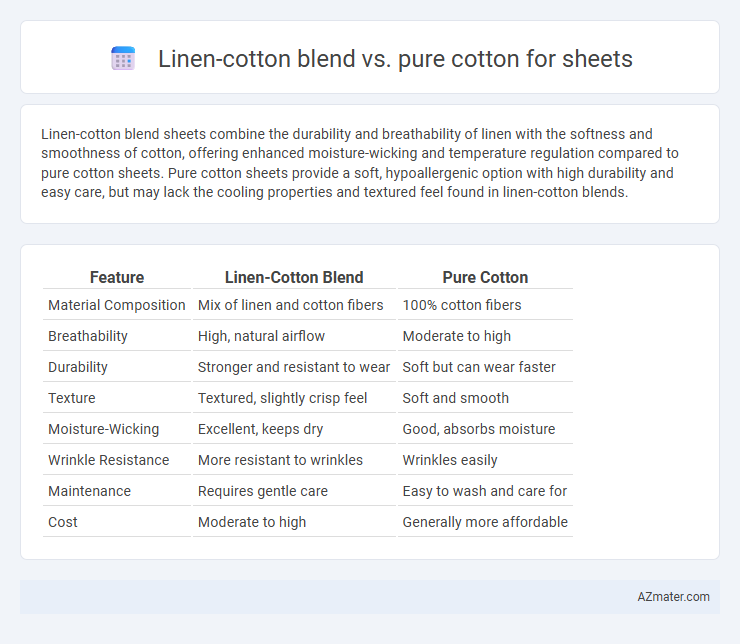Linen-cotton blend sheets combine the durability and breathability of linen with the softness and smoothness of cotton, offering enhanced moisture-wicking and temperature regulation compared to pure cotton sheets. Pure cotton sheets provide a soft, hypoallergenic option with high durability and easy care, but may lack the cooling properties and textured feel found in linen-cotton blends.
Table of Comparison
| Feature | Linen-Cotton Blend | Pure Cotton |
|---|---|---|
| Material Composition | Mix of linen and cotton fibers | 100% cotton fibers |
| Breathability | High, natural airflow | Moderate to high |
| Durability | Stronger and resistant to wear | Soft but can wear faster |
| Texture | Textured, slightly crisp feel | Soft and smooth |
| Moisture-Wicking | Excellent, keeps dry | Good, absorbs moisture |
| Wrinkle Resistance | More resistant to wrinkles | Wrinkles easily |
| Maintenance | Requires gentle care | Easy to wash and care for |
| Cost | Moderate to high | Generally more affordable |
Introduction to Linen-Cotton Blend vs Pure Cotton Sheets
Linen-cotton blend sheets combine the durability and breathability of linen with the softness and smoothness of cotton, offering a balanced fabric ideal for temperature regulation and moisture-wicking. Pure cotton sheets, particularly those made from long-staple varieties like Egyptian or Pima cotton, provide exceptional softness, durability, and a hypoallergenic surface that becomes more comfortable with each wash. Choosing between linen-cotton blends and pure cotton sheets depends on preferences for texture, breathability, and maintenance requirements.
Fabric Composition: What Sets Them Apart
Linen-cotton blend sheets combine flax fibers from linen with cotton fibers, creating a fabric that balances the breathability and moisture-wicking properties of linen with the softness and durability of cotton. Pure cotton sheets, typically made from long-staple cotton such as Egyptian or Pima, offer a smooth, hypoallergenic texture renowned for its comfort and strength. The hybrid fabric composition of linen-cotton blends results in enhanced temperature regulation and wrinkle resistance compared to the single-fiber composition of pure cotton sheets.
Breathability and Temperature Control
Linen-cotton blend sheets offer superior breathability compared to pure cotton due to linen's natural moisture-wicking properties, which help regulate body temperature more effectively. Pure cotton sheets, while soft and durable, tend to retain more heat and moisture, making them less ideal for hot sleepers or humid climates. The combination of linen's crisp texture and cotton's softness in blended sheets provides an optimal balance for cooler, drier sleep environments.
Durability and Longevity Comparison
Linen-cotton blend sheets offer enhanced durability due to the strength of linen fibers, which resist wear and tear better than pure cotton alone. Pure cotton sheets tend to be softer initially but may wear out faster with frequent washing and prolonged use, leading to pilling and fabric thinning. The natural resilience of linen in the blend improves longevity, making linen-cotton sheets a more durable option for long-term use.
Comfort and Texture: Feel Against the Skin
Linen-cotton blend sheets offer a unique texture combining the smooth softness of cotton with the breathable, slightly coarse feel of linen, resulting in enhanced airflow and a cool sensation against the skin. Pure cotton sheets provide a consistently soft, smooth surface that adapts comfortably to body temperature, making them ideal for sensitive skin and year-round use. The blend's tactile complexity promotes durability and moisture-wicking properties, while pure cotton excels in gentle, hypoallergenic comfort.
Moisture-Wicking and Absorbency
Linen-cotton blend sheets excel in moisture-wicking due to linen's natural breathability, drawing sweat away from the body and promoting faster evaporation compared to pure cotton sheets. Pure cotton sheets offer high absorbency, effectively soaking up moisture but retaining it longer, which can lead to a damp feeling during extended use. For optimal comfort in warm climates or for hot sleepers, linen-cotton blends balance moisture control and softness, whereas pure cotton prioritizes absorbency with a softer texture.
Care, Maintenance, and Ease of Cleaning
Linen-cotton blend sheets offer enhanced durability and resistance to wrinkles compared to pure cotton, requiring gentler washing cycles and cold water to preserve fabric integrity. Pure cotton sheets are more prone to shrinkage and may need higher temperature washes for effective stain removal, but they respond well to ironing and bleach for maintenance. Both fabrics benefit from air drying to maintain softness and longevity, though linen-cotton blends typically dry faster due to linen's natural breathability.
Eco-Friendliness and Sustainability
Linen-cotton blend sheets offer enhanced eco-friendliness due to linen's natural durability and lower water consumption compared to pure cotton cultivation, reducing environmental impact. Pure cotton, while breathable and soft, often requires intensive water use and pesticides, posing sustainability challenges. Choosing a linen-cotton blend supports sustainable textile practices by combining linen's resource efficiency with cotton's comfort, promoting longer-lasting, environmentally conscious bedding options.
Price Point and Value for Money
Linen-cotton blend sheets typically command a higher price point than pure cotton due to the combined benefits of durability, breathability, and natural texture. Pure cotton sheets offer excellent softness and affordability, making them a popular budget-friendly choice with reliable comfort. The blend provides greater value for money by balancing the luxury feel of linen with the cost-effectiveness and ease of care of cotton.
Choosing the Best Option for Your Needs
Linen-cotton blend sheets offer enhanced breathability and durability, making them ideal for hot climates and those seeking long-lasting bedding with a crisp texture. Pure cotton sheets, especially those made from high-quality Egyptian or Pima cotton, provide superior softness and a smooth feel, perfect for individuals prioritizing comfort and natural fiber purity. Selecting between these two depends on whether you value moisture-wicking and resilience or unmatched softness and traditional cotton comfort.

Infographic: Linen-cotton blend vs Pure cotton for Sheet
 azmater.com
azmater.com